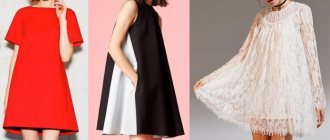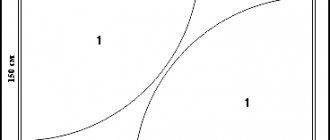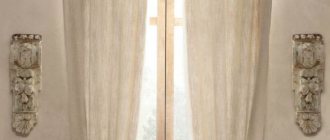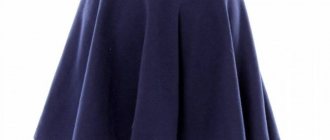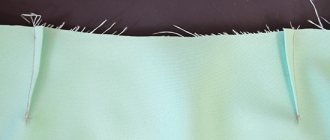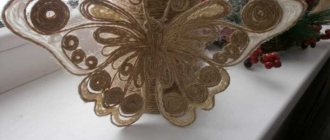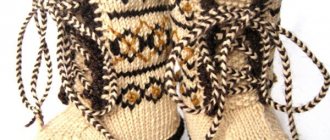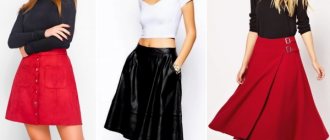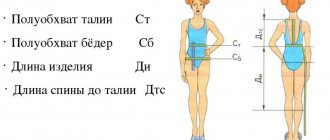Among the wide variety of modern models, a dress with a flared skirt occupies a special place. This style has been popular among fashionistas for centuries. Despite the fact that the pattern of a dress with a circle skirt is very simple, it looks attractive on any body type.
Skirts usually have one or two seams; there may be models without seams. The length of such dresses is also varied - from mini to maxi.
Dresses with a circle skirt can be either with sleeves of different lengths or without them at all. A fashionable shirt dress is ideal for the office, and a sundress with straps is ideal for a summer holiday.
Types of skirts
The pomp of a skirt depends on its volume. Under the general name of the circle skirt there are at least four options for women's skirts:
- full sun;
- 3/4;
- 1/2 or half sun;
- 1/4 or quarter.
All types are shown schematically in the figure below.
The difference between cutting these models of skirts for beginners is shown in the following figure.
In addition to the skirts listed, you can also sew a dress with a double and triple sun skirt.
Street style
The peculiarity of this style in tailoring models with a full skirt is the combination of various textures and colors that merge into a cohesive look.
This direction is suitable for those individuals who are open to everything new and are not afraid to experiment.
For example, you can create a corset dress with a full skirt, which is matched with tiger print shoes. The main thing is not to be afraid to make a mistake and look for your own image. Inspiration will suggest the most interesting options. Ideas for a unique look can be drawn from various sources, combining and modifying the things you like.
Layout of patterns on fabric
The arrows in the figures indicate the direction of the warp threads of the material.
With a fabric width of 1.4-1.6 m, the patterns are laid out offset. This option is also chosen for checkered fabrics, since it is possible to ensure alignment of the pattern. A three-seam skirt option is shown.
With a fabric width of 1.6 m, the patterns are laid out mirror-like. This option is also chosen for checkered fabrics, since it is possible to ensure alignment of the pattern. Shown is a version of a two-seam double sun skirt.
One pattern can be laid out on a narrow fabric folded into a scarf. For a two-seam double sun skirt, you need to cut out two parts.
When using fabric with a width of 1.6-2.0 m, the patterns are laid out along the fold of the cut. For a two-seam double sun skirt, you need to cut out two parts.
We offer you ready-made sun dress patterns for two sizes – 44 (euro) = 50 (Russian) and 46 (euro) = 52 (Russian).
Step-by-step sewing instructions
Having cut out the parts with allowances, we begin sewing. Sew and press the shoulder and side seams. We process the cuts of the neckline and armholes with an oblique facing. We sew a seam on the skirt, leaving an area for sewing in a zipper. We sew in a zipper. We baste the bodice and skirt. We sew a machine seam. We process the waist allowance and iron it onto the bodice.
LiveInternetLiveInternet
—Categories
- Dresses (805)
- We knit dresses (502)
- We sew dresses (300)
- fabric+knitting (9)
- Hats, berets (412)
- We knit hats (358)
- We sew hats (54)
- Knitting (372)
- Knitting (113)
- Crochet (91)
- Raglan knitting (58)
- Sweatshirts, sweaters (29)
- Knitting bolero (14)
- knitting for children (2)
- Sew (312)
- Knitting top (200)
- Hair jewelry (188)
- booties, socks (131)
- We knit skirts (130)
- Scarf, snood (122)
- Everything from the newspaper (117)
- We sew skirts (110)
- Knitting technique (102)
- Alterations (102)
- Flowers (99)
- sewing technique (98)
- Recipes (86)
- Drawing, copybook (79)
- Easter (71)
- Furniture (70)
- Paper crafts (69)
- Candy bouquets (56)
- Hairstyles (56)
- English (52)
- Crafts (52)
- Bracelets, earrings, beads (51)
- Secrets (51)
- For storage (51)
- Crochet patterns (46)
- Fleece (44)
- For children (42)
- Birthday (40)
- Knitted items (33)
- Bags, cosmetic bags (32)
- We sew crafts (32)
- Beauty secrets (29)
- Crafts with kids (25)
- Curtains (23)
- COATS AND CARDIGANS (21)
- Knitting needle patterns (21)
- Knitting for men (20)
- Beautiful bottles (19)
- Snack recipes (17)
- For vegetable garden (17)
- Collars (17)
- Knitted overalls, pants (14)
- Repair (14)
- Miscellaneous (14)
- Salad recipes (13)
- snowflakes (13)
- Poems (13)
- Toys (13)
- Speech therapist (12)
- Swimwear (10)
- New Year (10)
- Blankets, bedspreads (10)
- Steamer recipes (10)
- Computer (9)
- Foam figures (9)
- Plasticine (8)
- Cake recipes (8)
- Everything from plastic bottles (7)
- Beads (6)
- Makeup (6)
- music (5)
- MARRIGALS (4)
- Fabric printing (4)
- sewing technique (3)
- Health (3)
- Links (3)
- Cardboard (3)
- Photos (3)
- Holidays (2)
- Napkins (2)
- Fabric rugs (2)
- Toys (2)
- Coloring pages (2)
- Study (1)
- costume jewelry (1)
- (1)
- Garden crafts (1)
-Music
—Search by diary
—Subscription by e-mail
— Regular readers
—Communities
-Statistics
Evening dress with sun skirt
To model the product, a simple basic pattern of a straight dress with two waist darts is used. Close the vertical dart by moving it to the side.
The modeling of the upper part of the front is shown in the following drawing. We shorten the side dart by 2 cm. Through the upper points of the darts we draw a pattern curve that limits the bottom of the cut-off part of the bodice. Lower the waistline 5 cm down. Along the line of the middle front we measure 24 cm from the bottom of the rollout. Through this (∙) and the bottom of the armhole we draw the pattern border of the cutting part of the bodice.
The part that will be draped is shown with blue lines on the pattern. We will retake it using a separate pattern. The draped insert is sewn from a double-length cut. Cut off the top of the dress and the middle part. We cut the last one along the darts, there will be raised seams.
Modeling of the back pattern is shown in the following figure. This piece is also cut along the darts to make raised seams.
To make a circle skirt, measure the OB at a height of 5 cm below waist level. The skirt consists of two parts. On the back panel you need to make a cut to sew in a zipper.
We reinforce the upper part of the bodice with thermal fabric and drape it. We also reinforce the elements of the middle zone with thermal fabric. We sew the bones into the raised seams.
The skirt for this model will be made in two layers.
For the top of the dress, a lining is made, which is cut out according to the patterns of the main parts.
Skirt double sun
This floor-length skirt is popular in theater costumes and dance outfits. This cut can also be used for summer dresses made of thin draping fabric.
The double sun skirt pattern is very simple, it is presented below.
Step-by-step master class on sewing a gypsy skirt
For a skirt 95 cm long you need:
- bright fabric with a floral pattern – 4.5 m;
- satin – 3.5 – 4.0 m;
- chiffon – 1.5 m.
Let's start by taking measurements:
- OT = 59 cm;
- OB = 82 cm;
- DU = 95 cm.
Let's calculate the length of the main part. We take the width of the belt = 4 cm, flounce = 20 cm. Total length of the main part = 95 cm – (4 + 20) = 71 cm.
To cut out the main pattern, we define two radii.
R1 = FROM:6.28 = 59:6.28 = 9.4 cm. We divide the result by two, since our skirt is a double sun. We get R1 = 4.7 cm. Calculate R2 = R1 + length of the skirt without frill = 75.7 cm. Immediately add allowances to the result (= 2 cm). We are making a pattern.
Since we are sewing a double sun skirt, we need to cut out four semicircles.
Then we cut out the shuttlecock. Patterns for various flounces can be easily found on the Internet or in sewing magazines, for example in the Burda magazine.
Lay out the shuttlecock pattern on the fabric and cut it out. Then we measure the length of the upper cut and calculate the required number of flounces. To do this, divide the total length of the lower section of the skirt by the length of one flounce. In our case, it came out to 9.5 pieces.
Now let's do the frill. Its width is 10 cm plus 2 cm for seams. We use a coefficient of 1.5 to calculate the length of the frill. Multiply the length of the hem (= 10.4 m) by 1.5. We got 15.6 m. With a fabric width of 1.5 m we get 15.6: 1.5 = 10.5 stripes.
For the belt, we cut out a strip 12 cm wide and 102 cm long. The width of the elastic band is 5 cm.
Let's start sewing a skirt by joining the skirt parts with an overlocker.
Fold the seam allowance over to one side and stitch it.
Sew together the edges of the elastic.
We sew together the ends of the belt blank.
Fold the belt 8 times and smooth the edges.
Sew the belt to the top edge of the skirt, evenly distributing the excess length along the waist. We fold the parts right sides together when sewing.
We mark eight sections on the elastic band. We combine the marks of the belt and elastic bands and secure with pins.
We attach the elastic with an overlocker. At the same time, we stretch the elastic, equalizing its length with the section of the belt.
Finished seam - see photo below.
We bend the belt to the wrong side and, carefully straightening it, attach it.
While stretching the belt, we perform a chain stitch, stepping back a little from the edge.
Repeat the line at short intervals.
View of the belt from the wrong side - see photo.
We thread a strong cord along the central section.
Iron the skirt and attach it with clothespins to the hanger so that it hangs.
We sew together the parts of the flounce and attach the allowances to the fabric. We repeat the previous algorithm.
We sew the edge.
Iron the shuttlecock.
We sew the details of the frill, sew the edge and gather it.
Smooth out the frill.
Since the skirt is cut with a variable direction of the grain thread, the material is also stretched unevenly. This is clearly visible in the photo.
We trim the length, cutting off the excess. It is more convenient to do this in several passes with scissors.
We get a smooth edge.
Attach the frill and flounce with an overlocker, leaving a small free area.
If, when attaching, we get extra length of the frill and flounce, cut it off. Then we sew the ends together. We cover the remaining area.
You can watch how to cut a double sun skirt directly on the fabric in a detailed video tutorial.
Individuality of evening dresses is a little less than knee length
In women's clothing, the average length dominates ( a physical quantity, a numerical characteristic of the length of lines
).
A midi dress with a fluffy skirt can be stylish, avant-garde, business-serious, romantic - the models of this clothing are different.
In addition, manufacturers produce collections of monochrome and multi-colored fabrics of various textures. The style with a full skirt is perfect for making similar dresses for mother and daughter. The Family look style presupposes neatness, elegance and a little romance - average length and size ( this word has several meanings: Degree of development, size, scale of some phenomenon
) hem is what is needed.
Thanks to its perfect length, a lady of any age and build can choose a suitable mid-length option.
Read about how and with what to wear a reddish dress in the following material.
All-in-one solution
In clothes of medium length, a lady of any build can look pretty. To focus on the advantages of the figure, such as a narrow waist, chic breasts, harmonious body proportions, there are midi models with a straight and fitted silhouette, topped with flounces, frills, pintucks and ruffles. When choosing an outfit, the fabric is also important.
A product made of light, floating fabrics will make an extra size, which is not suitable for corpulent ladies. Flowing textiles are more suitable for them.
From midi models, you can choose a knee-length dress and reveal beautiful thin legs, or choose an outfit that reaches mid-calf and divert attention from wide hips, visually lengthen your figure and give a slim silhouette.
Find even more indescribably chic and elegant styles of dresses for plus size women here.
Harmonious image of a lady
Every time you leave the house - for a walk around town, for a business meeting or an evening event - you need to dress in a different style. When selecting it, the fabric is taken into account ( textile fabric made on a loom by interweaving mutually perpendicular thread systems
) and model.
To create a set of business style ( Style (writing, stylus, stylus, stylus - lat. stilus, stylus from ancient Greek
) stylish products are suitable without rich frills, flounces and not very open.
A dress for the winter is made from fabrics that give warmth and comfort, with sleeves. You can come to work in a warm garment with short or long sleeves, cuffed or slightly widened at the bottom.
- An office dress should not be heavily decorated; beads or a small gold or silver chain with a pendant go well with it.
- A summer outfit that you can wear to work or school may be sleeveless, but not a sundress. Exciting models with dropped armholes and cap sleeves.
- In the hot weather, it’s cozy to wear clothes made from natural fabrics – linen, cotton, silk. A summer office dress does not have to be made of transparent fabrics.
- A business look will be complemented by exciting jewelry, but not flashy jewelry. With midi business clothes in the summer you can wear sandals and open heels, in the winter you can wear ankle boots, boots and ankle boots.
An expressive evening dress of medium length can be low-necked, with slits. It is distinguished from other outfits by the fabrics used for tailoring and unique decoration.
In a dressed-up version of a dress with a full skirt, expensive silk fabrics, satin, patterned fabric, guipure are combined with gold and precious stones, elegant shoes or stiletto sandals.
Sundress with sun skirt
For this model you need:
- stretch fabric – 1.4-1.5 m;
- the same fabric in a contrasting color - 0.9 m.
The sundress pattern for several sizes is presented below.
Need to cut:
- bodice;
- skirt;
- insert – strip 7 cm wide (including seam allowances).
The length of the skirt is 50 cm, the finishing strip is 15 cm wide.
How to sew a sundress
We make ties. We sew together the details and turn them inside out. We prepare the bias tape - we sew together the parts and iron them in half along the length.
We sew the darts on the bodice and sew the side seams. We use bias tape to trim the sides, armholes and top of the back. Fold the bodice flaps and sew them together at the waist.
Compare the length of the insert with the cut length of the bodice. The insert should be a little shorter, but allow you to put on the product without a fastener.
We sew the ends of the insert together and iron the seam. We sew the insert to the bodice, aligning the joining seam with the notch on the back of the bodice.
Then, we sew the skirt with the bodice, paying attention to the alignment of the notches.
We sew the skirt pieces into a common piece and attach it to the bottom edge of the sundress.
We process the bottom cut with a roller.
We try on the sundress and, having decided on the length of the ties, sew them on.
